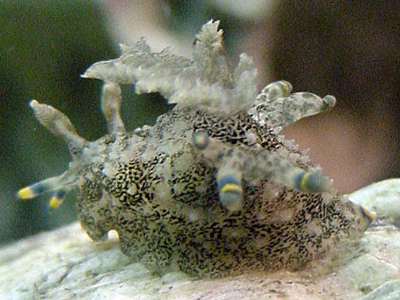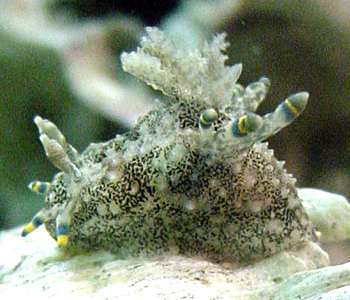

Polycera hummi
Abbott, 1952
Order: NUDIBRANCHIA
Suborder: DORIDINA
Superfamily: ANADORIDOIDEA
Family: Polyceridae
Subfamily: Polycerinae
DISTRIBUTION
Known from Florida and North Carolina - Atlantic coast of USA.
PHOTO
West coast of Florida [USA], near Tampa Bay, 1-2m deep. Approx 2cm long. Photo: Karen Mudgett
This species has the shape generally found in this genus, but has the following distingusihing features. There is no distinct notal edge separating the dorsal mantle from the sides of the body except for a series of elongate lateral papillae. Anteriorly there are two papillae on each side in front of the rhinophores, and posteriorly there are 3 or 4 papillae on each side, the anteriormost on each side being adjacent to the gill circle. These posterior papillae are often called 'extra-branchial processes'. Both the mantle and the sides of the body are covered in low conical pustules or papillae.
The background colour of the body is a translucent brownish grey, and all over the body is a close scattering of black or dark brown specks. The smaller conical papillae, gills and rhinophores are all translucent grey brown but the elongate lateral papillae have three characteristic colour bands - a subterminal blue band, followed by a yellow band and then another blue band about midway down each papilla.
This species was initially described from 5 preserved decolourised specimens from Alligator Harbour, Florida, but fortunately a living specimen from Alligator Harbour, and notes on living specimens from Beaufort, North Carolina, were made available to the author while he was preparing to publish his description. Without the 'additional notes' on the living animal, which is attached at the end of his description, this species would have been unidentifiable. This species has been rarely reported in the literature since its original description. Marcus (1961) describes anatomical details of a single specimen from Beaufort, Nth Carolina, and Eyster (1980) reports animals up to 22mm long and their egg masses from Georgetown County, Sth Carolina. They were on the arborescent bryozoan Bugula, which is most probably its food.
See the similarly coloured Polycera aurisula.
References:
• Abbott, R.T. (1952) 2 new opisthobranch mollusks from the Gulf of Mexico belonging to the genera Pleurobranchaea & Polycera. Florida State University Studies, No. 7. Papers from the Oceanographic Institute: 1-7, pls. 1,2. [Including: Additional notes on Polycera hummi.]
• Eyster, L. S. (1980) Distribution and reproduction of shell-less opisthobranchs from South Carolina. Bulletin of Marine Science, 30(3): 580-599.
• Marcus, Er. (1961) Opisthobranchia from North Carolina. Journal of the Elisha Mitchell Scientific Society, 77(2): 141-151
Rudman, W.B., 2004 (January 7) Polycera hummi Abbott, 1952. [In] Sea Slug Forum. Australian Museum, Sydney. Available from http://www.seaslugforum.net/factsheet/polyhumm
Related messages
-
Polycera hummi from Gulf of Mexico
From: Kasey L. Grace, June 1, 2010 -
Polycera hummi from Mississippi, USA
From: Gretchen Grammer, November 21, 2007 -
Re: Polycera hummi from North Carolina
From: Anthony Fernando, December 6, 2006 -
Polycera hummi from North Carolina
From: Tony Fernando, November 22, 2006 -
Re: Polycera hummi from Florida
From: Karen Mudgett, July 11, 2004 -
Re: Polycera hummi from Florida
From: Karen Mudgett, January 12, 2004 -
Egg-ribbon of Re: Polycera hummi
From: Karen Mudgett, January 12, 2004 -
Polycera hummi from Florida
From: Karen Mudgett, January 9, 2004
